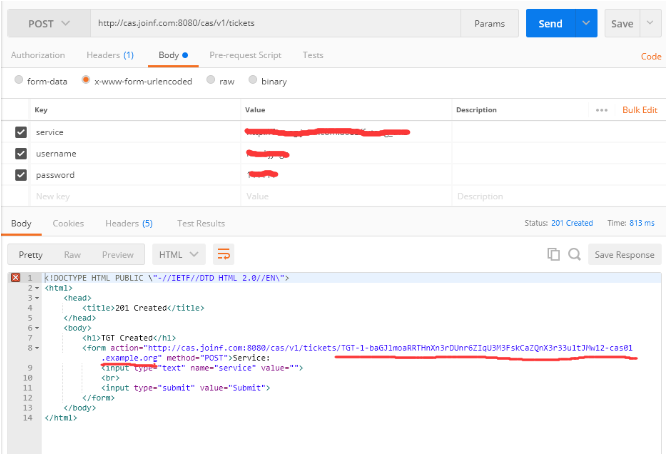关于Cas的认证原理、Rest的使用请参考前面的文章。本文重点阐述使用Rest接口登陆系统和其他单点登录系统打通遇到的问题,及解决问题的思路和过程。
一: 遇到的问题
使用Rest接口实现登陆后,再访问其他使用Cas单点登陆的系统时,Cas认定为当前用户未登陆并要求登陆。经过分析发现,当访问其他使用Cas单点登录系统时Cas无法获取到当前客户端Cookie中的TGC,也就是说使用Rest接口实现登陆Cas无法往客户端Cookie写入TGC。有关TGC的解析这里不详述。
问题适用场景
- 部分系统使用授权免登的方式进入到CAS单点登录系统,同时又希望能使用SSO切换到其他系统。
- 部分业务系统有自己的登陆页面,在自己的登陆逻辑中调用Cas的Rest接口实现登陆,同时希望能使用SSO切换到其他系统
二: 解决问题过程
- 分析Rest接口发现,调用 cas/v1/tickets/ 接口登陆成功后cas返回了用户的身份信息TGT,那么TGT和TGC有什么关联呢?
 收发
收发
2. 继续分析cas登陆流程,Cas使用spring-webflow控制登陆流程,找到WEB-INF/webflow/login/login-webflow.xml。在flow执行之前Cas先做了些处理,如下配置
<on-start>
<evaluate expression="initialFlowSetupAction"/>
</on-start>追踪到InitialFlowSetupAction类的doExecute方法发现核心代码:
WebUtils.putTicketGrantingTicketInScopes(context,this.ticketGrantingTicketCookieGenerator.retrieveCookieValue(request));
代码说明:当用户访问Cas登陆页时,程序调用this.ticketGrantingTicketCookieGenerator.retrieveCookieValue(request)方法获取TGT并存放入当前作用域中。
继续追踪到CookieRetrievingCookieGenerator类的retrieveCookieValue方法中:
try {
final Cookie cookie = org.springframework.web.util.WebUtils.getCookie(
request, getCookieName());
return cookie == null ? null : this.casCookieValueManager.obtainCookieValue(cookie, request);
} catch (final Exception e) {
logger.debug(e.getMessage(), e);
}
return null;代码说明:逻辑比较简单,直接从cookie中获取TGC(getCookieName()方法有兴趣可以追踪下看看),如果TGC不为空,调用this.casCookieValueManager.obtainCookieValue(cookie, request)方法解析TGC得到TGT,问题逐渐明朗了,TGT是根据TGC获取到的。
再追踪到DefaultCasCookieValueManager(为什么选择DefaultCasCookieValueManager实现类,有兴趣可以追踪看看)类的obtainCookieValue方法中:
final String cookieValue = this.cipherExecutor.decode(cookie.getValue());
LOGGER.debug("Decoded cookie value is [{}]", cookieValue);
if (StringUtils.isBlank(cookieValue)) {
LOGGER.debug("Retrieved decoded cookie value is blank. Failed to decode cookie [{}]", cookie.getName());
return null;
}
final String[] cookieParts = cookieValue.split(String.valueOf(COOKIE_FIELD_SEPARATOR));
if (cookieParts.length != COOKIE_FIELDS_LENGTH) {
throw new IllegalStateException("Invalid cookie. Required fields are missing");
}
final String value = cookieParts[0];
final String remoteAddr = cookieParts[1];
final String userAgent = cookieParts[2];
if (StringUtils.isBlank(value) || StringUtils.isBlank(remoteAddr)
|| StringUtils.isBlank(userAgent)) {
throw new IllegalStateException("Invalid cookie. Required fields are empty");
}
if (!remoteAddr.equals(request.getRemoteAddr())) {
throw new IllegalStateException("Invalid cookie. Required remote address does not match "
+ request.getRemoteAddr());
}
if (!userAgent.equals(request.getHeader("user-agent"))) {
throw new IllegalStateException("Invalid cookie. Required user-agent does not match "
+ request.getHeader("user-agent"));
}
return value;代码说明:首先解密TGC后得到一个由@符号分隔的字符串,分隔后获取到TGT、客户端IP、客户端代理信息。并将从TGC中解密的客户端IP信息和客户端代理信息与当前请求的客户端IP信息和客户端代理信息进行比较,若不相等就抛出异常(Cas的安全策略)。
- 回到问题的根源,当业务系统调用Cas的Rest接口实现登陆,再切换到其他单点登录系统时,先请求Cas的登陆授权页面,当程序调用this.ticketGrantingTicketCookieGenerator.retrieveCookieValue(request)获取TGT时,此时客户端的TGC为空自然无法解析出TGT。
- 思考:既然调用Rest接口实现登陆有返回TGT信息,是否可以再请求一遍Cas的登陆授权页面并传入TGT信息,然后修改源码将TGT加密为TGC并加入到客户端的cookie中,此时Cas认定为当前用户为已登陆并重定向回service地址。
- Cas的登陆授权页面需要改造获取传入的TGT信息,还是需要到InitialFlowSetupAction类的doExecute方法进行处理
改造前:
WebUtils.putTicketGrantingTicketInScopes(context, this.ticketGrantingTicketCookieGenerator.retrieveCookieValue(request));
改造后:
String cookie = this.ticketGrantingTicketCookieGenerator.retrieveCookieValue(request);
//增加从request中获取tgt
if (cookie == null && request.getRequestURI().contains("/login")) {
String tgt = request.getParameter("tgt");
if (StringUtils.isNotBlank(tgt)) {
HttpServletResponse response = WebUtils.getHttpServletResponse(context);
//TGT生成为TGC并添加客户端cookie中
this.ticketGrantingTicketCookieGenerator.addCookie(request, response, tgt);
//tgt直接付值给cookie
cookie = tgt;
}
}
WebUtils.putTicketGrantingTicketInScopes(context,cookie); 将login-flow.xml中on-start配置修改为自定义的initialFlowSetupExAction
<on-start>
<evaluate expression="initialFlowSetupExAction"/>
</on-start>
关于 this.ticketGrantingTicketCookieGenerator.addCookie(request, response, tgt);方法有兴趣的朋友可以追踪看看。
客户端改造:调用Cas的Rest接口登陆成功后,解析出返回的TGT,并重定向到Cas的登陆页面加上service和tgt参数即可
例:
https://cas.xxxx.com/cas/login?service=https://xxx.xxxx.com&tgt=TGT-817-6QBDc0n7Impr0EguA3mFpaViSeTOEzsMbefbW629nZRihFznoH-cas01.example.org
望大家不吝指教,有任何错误、疑问多交流。
版权声明:本文为博主原创文章,转载需注明出处。http://www.cnblogs.com/bryanx/p/8588270.html


